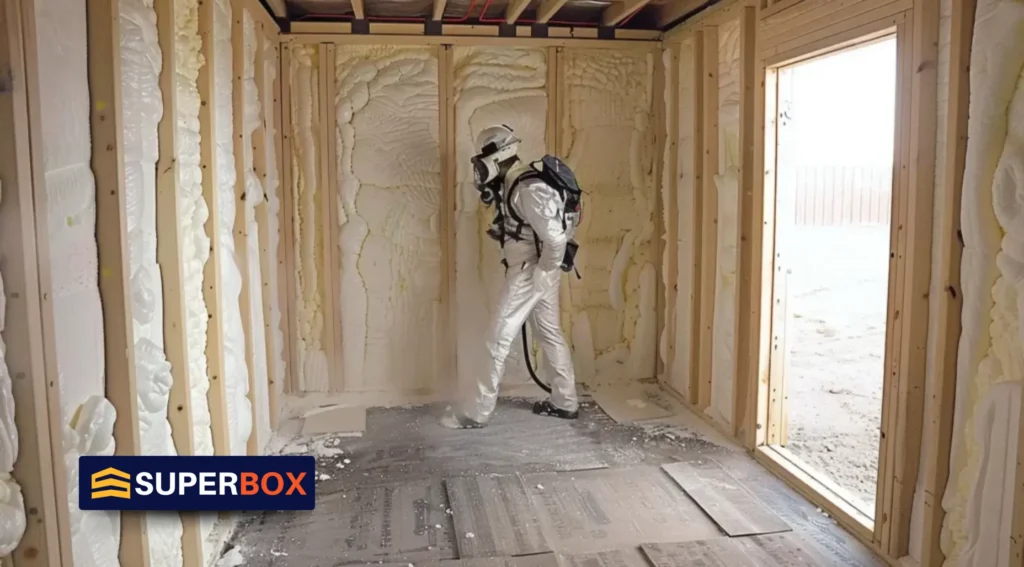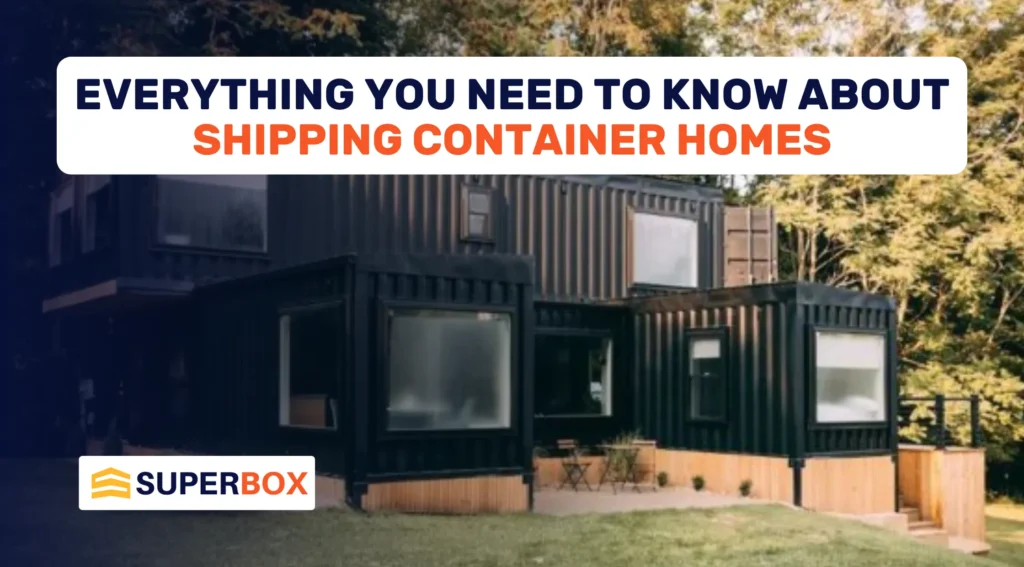In recent years, shipping container homes have become increasingly popular. These homes offer a unique and often more affordable alternative to traditional houses. In this blog, we’ll explore what shipping container homes are, their advantages and disadvantages, and what you need to consider if you’re considering building one.

What is a Shipping Container Home?
A shipping container home is exactly what it sounds like a house made from repurposed shipping containers. These containers are typically made of corten steel, which is a durable material designed to withstand the tough conditions of being transported across oceans. Because of their strength and durability, shipping containers are becoming a trendy option for those looking to build a home.
Pros and Cons of Shipping Container Homes
Shipping container homes are becoming a popular option for people looking for innovative and eco-friendly housing. By reusing old shipping containers, individuals can create unique living spaces. However, like any housing option, there are both benefits and drawbacks. Let’s take a look at the pros and cons of shipping container homes to help you decide if this unconventional choice is right for you.
Pros
- Affordable: Building a home from shipping containers can cost less than traditional homes, helping you save money on construction.
- Eco-Friendly: By using old containers, you help reduce waste and support environmentally friendly practices.
- Strong and Durable: Shipping containers are made from tough corten steel, so they can withstand harsh weather and last a long time.
- Unique Style: These homes have a distinctive industrial look that can be customized to match your taste.
- Faster to Build: Container homes can often be constructed more quickly than traditional houses, allowing you to move in sooner.

Cons
- Building Code Issues: Many places have specific rules for shipping container homes, which can make building them more complicated.
- Insulation Challenges: Properly insulating a shipping container can be tricky, so it’s important to choose the right materials to keep your home comfortable.
- Limited Space: The initial size of a container might be smaller than a traditional home, which may require creative solutions for storage and layout.
- Risk of Rust: If not properly maintained, shipping containers can develop rust, especially in damp areas.
- Financing Difficulties: Some banks may be reluctant to give loans for shipping container homes, making it harder to get a mortgage.
By considering these pros and cons, you can better understand whether a shipping container home is the right choice for your lifestyle and budget.

Designing Your Living Space
When planning your shipping container home, it’s important to think about how to make the most of the available space. Shipping containers typically come in sizes of 20 feet or 40 feet long, which gives you different options depending on how much square footage you want to work with. Careful layout planning is essential to ensure that your interior space feels comfortable and functional.
Tips for Maximizing Space:
- Open Floor Plan: One of the best ways to make your living area feel larger and more inviting is by using an open floor plan. This design removes unnecessary walls, allowing light to flow freely and creating a sense of openness that can make even smaller spaces feel more expansive.
- Multi-Functional Furniture: Another smart strategy is to choose furniture that serves multiple purposes. For example, you could use a bed that doubles as a couch, or a table that can expand when you have guests. This kind of furniture helps you maximize the square footage of your home, ensuring that every piece you choose contributes to the overall function of your space.
- Vertical Storage: Since floor space is often limited in shipping container homes, it’s a good idea to think vertically. Utilize your walls for shelves and storage solutions, which can keep your interior space tidy and free up the floor area. By going up instead of out, you can make the most of your square footage and create a more organized living environment.
By incorporating these tips into your design, you can effectively maximize the space in your shipping container home, ensuring it meets all your needs while still feeling open and inviting. Whether you have one shipping container or multiple shipping containers combined, thoughtful planning will help you create a functional and stylish living space.

Building a Container Home
Constructing a shipping container house involves several important steps that you’ll need to follow to ensure a successful project. Here’s a breakdown of the process:
- Planning and Design: Begin by creating detailed blueprints for your home. This is a crucial step because your plans need to comply with local building codes and regulations. Taking the time to plan carefully will help you avoid any issues or delays later on in the construction process.
- Site Preparation: After you have your design ready, it’s time to choose the best location for your container home. Consider factors like access to utilities, sunlight, and privacy. Once you’ve picked a spot, you’ll need to prepare the land. This may involve clearing away any vegetation, leveling the ground, and laying a solid foundation to support your container.
- Container Modification: Once your site is ready, you can focus on the shipping containers themselves. Depending on your design, you may need to make modifications, such as cutting openings for windows and doors. It’s essential to make these changes carefully to ensure the structural integrity of the containers is maintained.
- Insulation and Utilities: After modifying the containers, it’s crucial to insulate them properly. Good insulation will help keep your home comfortable in different weather conditions. You’ll also need to connect essential utilities like water and electricity. This might involve hiring professionals to ensure everything is done safely and correctly.
By following these steps, you can successfully build a shipping container home that meets your needs and fits your lifestyle. Each stage is important, so take your time and plan carefully to create a comfortable and functional living space.
Comparing Container Homes to Traditional Housing
When you look at home costs, shipping container homes can often be cheaper per square foot than traditional homes. This is especially appealing to those on a budget. However, while container homes may be less expensive initially, you should also consider potential hidden costs, like additional insulation or custom modifications.
Advantages of Traditional Homes:
More Space: Traditional homes generally offer more space and layout flexibility.
Familiar Building Process: The process of building traditional homes is well-established, which can make it easier to navigate.
Disadvantages of Traditional Homes:
Higher Costs: Building a traditional home can be significantly more expensive, especially when you factor in land costs and materials.
Longer Construction Time: It often takes longer to build a traditional house compared to a shipping container home.
Types of Insulation for Shipping Container Homes
Insulation is a critical aspect of making your shipping container home comfortable, especially since metal can heat up or cool down quickly. Here are some common types of insulation you might consider:

- Spray Foam Insulation: This is a popular choice because it creates a tight seal and provides excellent insulation. However, it can be more expensive than other options.

- Rigid Foam Boards: These boards are easy to install and can provide good insulation. They can be placed on the walls, ceiling, and floors.

- Traditional Batts: These are fiberglass batts that can be installed between the steel walls. They are often less expensive but may not perform as well in extreme temperatures.
Each type of insulation has its benefits and drawbacks, so it’s essential to choose the one that best fits your climate and budget.

Structural Integrity and Weather Conditions
One of the biggest concerns when building a shipping container home is ensuring structural integrity. The design and modifications you make should keep the home stable and safe, especially in areas prone to extreme weather conditions.
Tips for Ensuring Structural Integrity:
Foundation: Make sure you have a solid foundation to support the weight of the containers.
Reinforcement: Consider reinforcing the containers during modifications to maintain their strength.
Ventilation: Proper ventilation can help reduce moisture buildup, which can weaken the structure over time.
Popular States for Shipping Container Homes
If you’re considering building a shipping container home, it’s essential to know where you can legally do so. Many states have embraced this trend and allow shipping container homes with few restrictions. However, others may have strict regulations, so it’s crucial to check local laws.

- Texas: Known for its lenient regulations, Texas has become a hotspot for shipping container homes.

- California: Some areas in California allow container homes, especially if they meet specific sustainability criteria.

- Florida: Florida’s warm climate makes shipping container homes an attractive option and many local governments support this trend.
Conclusion
Shipping container homes presents a fresh and creative approach to housing. They combine sustainability, affordability, and unique design appealingly. Although there are some challenges, such as understanding building codes and addressing insulation requirements, the benefits make them an exciting option for many people.
If you’re considering building a shipping container home, it’s important to do your research and plan thoroughly. With the right preparation, you can create a beautiful and comfortable living space that fits your needs, even if you’re working with limited square feet. Whether your goal is to save money, reduce your environmental footprint, or simply enjoy a one-of-a-kind home, shipping container houses might be the perfect choice for you.
Exploring Shipping Container Homes with SuperBox!
Are you interested in exploring the exciting world of shipping container homes? At SuperBox, we provide a wide range of shipping containers designed to help you create your dream living space. Whether you’re looking for a unique, eco-friendly home or an affordable housing solution, we have the perfect container for you.
Our containers come in various sizes and styles, allowing you to customize your living space to fit your needs. Plus, our team is dedicated to ensuring your satisfaction, guiding you through the entire process—from selection to delivery.
Don’t wait any longer to turn your vision into reality! Contact us today at 1-866-696-9269 to learn more about our products and how we can assist you in starting your shipping container home journey. Let’s build something amazing together!





